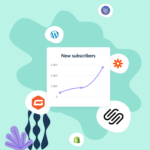Hi, Ramy. Tell us a little about your background.
I currently live in Brighton, UK and am the founder of a QR code generator called Hovercode. Before Hovercode, I ran Page Flows, which is a design resource that was acquired last year.
What motivated you to start Hovercode?
After running Page Flows for ~5 years, I was getting bored and wanted to explore new opportunities. Over the course of 3 months in 2020, I built and launched 3 simple products, one of which was Hovercode. I had various ideas, but wanted to quickly launch a few to gauge interest. It was my way of avoiding analysis paralysis. A few months after the multi-launch experiment, it was clear that Hovercode had the most potential (the other two products flopped).
I was interested in QR codes because, like everyone else, I noticed that they were finally being adopted (at least here in the UK). They were being added to all sorts of marketing materials and people were actually scanning them.
Even though they were everywhere, most QR codes were being used in incredibly basic ways so my theory was that marketers would start to use them in more sophisticated ways and there were still opportunities to get involved.
How have you grown this project since its inception?
Initial growth came from search engine traffic. Before writing any code, I did some keyword research (using Keywords Everywhere) to see what QR code related features people were looking for. I built those features first and created landing pages for them.
Over time, a few of those pages started to appear in search results and get clicked. Keyword research is so useful because it gives you an idea of what to build as well as how to get discovered.
We also built an integration with Canva early on which has worked out really well. It makes sense that people want to create QR codes where they are creating posters, leaflets, business cards etc, so it’s an ideal fit.
We now hear more and more that people are finding us through recommendations and word of mouth.
How does Hovercode use email marketing? Who’s on your subscriber list, and what are you talking to them about?
We mostly use EmailOctopus to send a welcome email to every person who signs up. As simple as that is, it’s proven to be a key driver of our growth.
Initially, the welcome email was a basic introduction and an opportunity for customers to let us know if there’s anything we can help with. This was incredibly helpful early on when we had a few bugs and plenty of missing features. Without the welcome email, people would have silently stopped using Hovercode without us knowing why. Responses to the welcome email made it clear which features we should prioritise.
Recently, I read an article from Justin Jackson recommending a different type of welcome email. It’s more focussed on learning about how people find you and what their “job to be done” is. We combined this approach with a line at the end of the email that still gives people an opportunity to let us know if they encountered any issues and it’s been working like a charm. People now respond to tell us why they are trying Hovercode and how they found us. Some of the responses lead to back-and-forth conversations and have been key to helping us understand our customers better.
If people sign up via Canva, we send a slightly different variation of the welcome email as they tend to ask different questions and it’s pretty obvious how they discovered us.
We use the EmailOctopus API as well as the automation feature for the welcome emails. We use tags to track where people signed up from and if they opted into the newsletter. Then we use an automation to send them the welcome email an hour after they signed up. If they didn’t opt into the newsletter, we remove them from our list automatically.
We occasionally send product updates to the newsletter, but not nearly often enough!
Why did you choose EmailOctopus as your email marketing platform?
I tried a few options a few years ago and EmailOctopus came out on top. It had all of the features I needed and was quick and easy to get started with. I haven’t found a reason to look elsewhere since. In the few instances I needed to contact support, they were super responsive and helpful which makes me confident in my decision to stick with EmailOctopus.
How has EmailOctopus benefitted you the most?
Other than the simplicity and speed, my favorite thing about EmailOctopus is that I can easily use it for multiple projects. While Hovercode is my main focus, I dabble with side projects at Rocket Gems and use EmailOctopus for all of them. Whenever I start something new, I can have an email list and an automated welcome email set up within minutes.
What tips can you share with others to get the most out of EmailOctopus?
If you don’t already send a welcome email, I recommend setting one up right away. It’s a super simple way to start conversations with your customers. Keep it short and simple – the welcome email doesn’t need to be flashy.
I also recommend contacting customer support if you have any questions or are unsure about anything. I’m generally quite hesitant to contact support because my experience with other companies hasn’t been great, but I have always found the people at EmailOctopus knowledgeable and helpful.


No Comments
Leave a comment Cancel